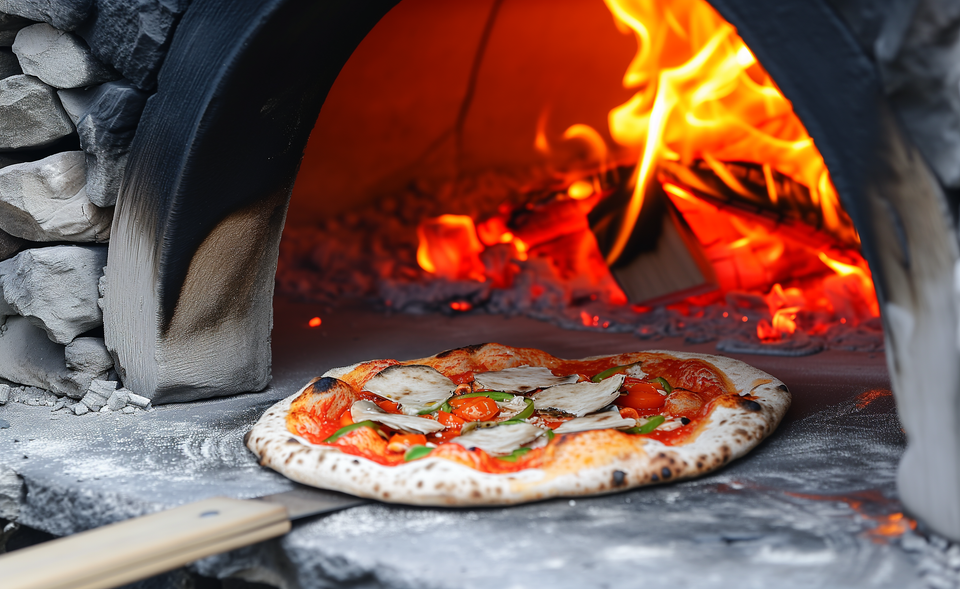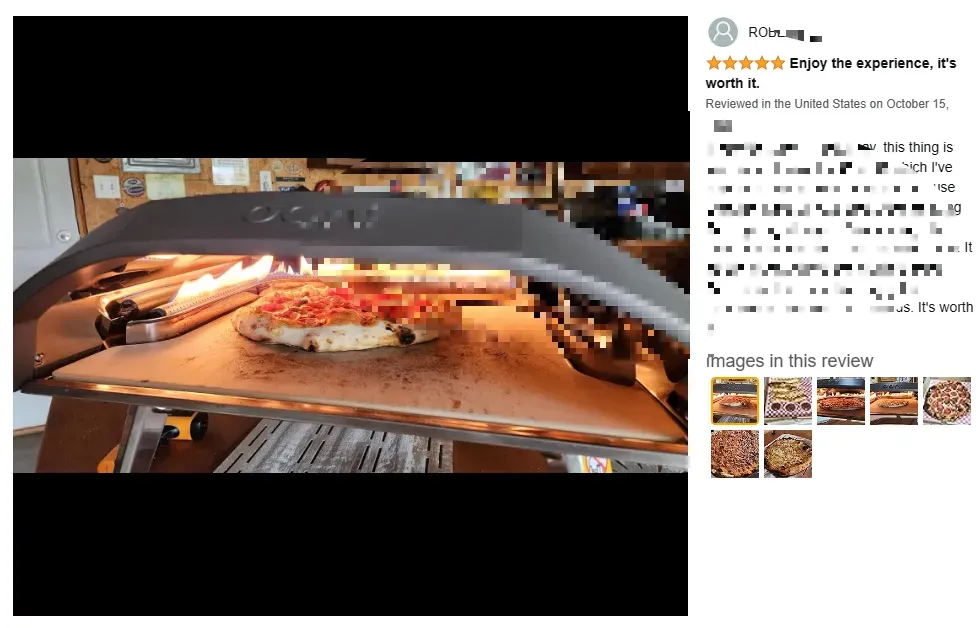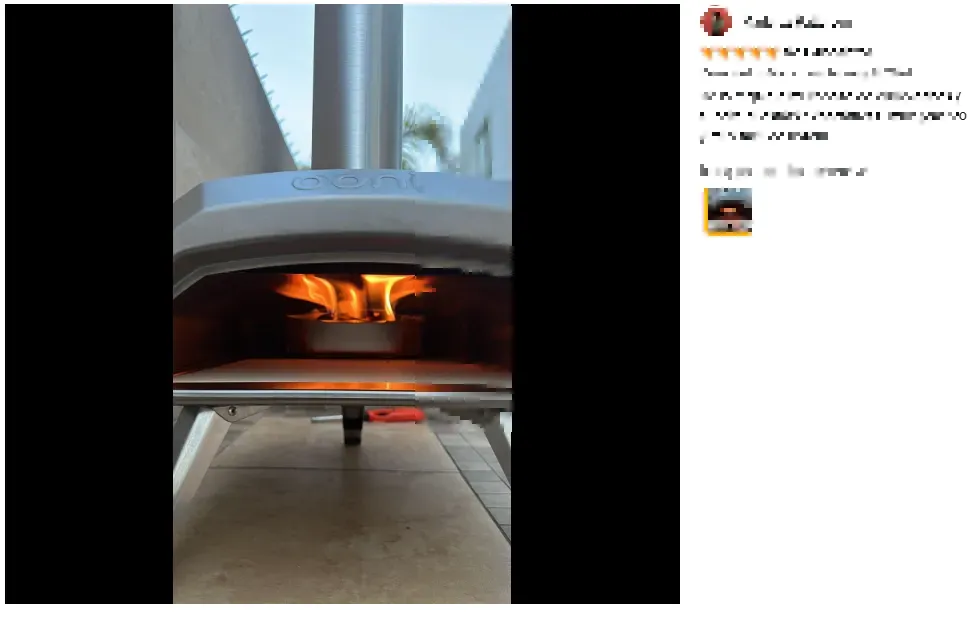What Makes a Pizza Oven Different

A pizza oven is different because it reaches much higher temperatures, often over 800°F (426.70°C), allowing it to quickly bake the crust into a crispy yet chewy texture with smoky, wood-fired flavors. The specialized engineering spreads heat evenly for consistent results. Portable options provide flexibility
Scorching Temperatures for Perfect Crust
Pizza ovens are designed to reach extremely high temperatures, typically 800-1000°F (426 -538°C). This allows the crust to quickly bake into the ideal texture - crispy and charred on the outside, yet chewy and tender on the inside. According to pizza experts, these specialized ovens can heat up to 800% hotter than the average household oven that only reaches 350-500°F (176 - 260°C).
This extreme heat denatures the proteins in the dough rapidly, allowing moisture to escape and the crust to set before the interior over-bakes. Serious Eats notes, "A pizza oven is designed specifically for baking pizzas. The defining characteristics of these ovens are very high temperatures and heat sources that mimic the effects of cooking over an open fire."
Without intense heat, the extended baking time in a conventional oven causes the crust to dry out. Pizza oven reviewer Valerie Luu explains, "The high temperature cooks the pizza dough quickly without drying it out. This gives you the charred crust everyone loves but retains the soft and chewy texture on the inside."
According to chefs, the blistered, blackened spots and charring achieved in a pizza oven caramelize flavours for a more complex, nuanced taste. The Neapolitan-style pies baked in these specialized ovens provide the signature crust people crave in authentic pizza.
The extremely high temperatures achieved in pizza ovens rapidly transform dough on a molecular level through a process known as the Maillard reaction. This browning effect caramelizes the natural sugars present in the dough, enhancing flavor and aroma.
Chef Lidia Bastianich says, "That charred crust is full of complex aromatics you simply can't achieve at lower temperatures. It takes intense heat to break down the dough and create that next level of taste."

Even Heat Distribution for Consistent Results
In addition to raw temperature, pizza ovens are engineered for optimal heat circulation to prevent hot or cold spots. Brick and stone materials absorb and radiate heat evenly across the entire surface where the pizza sits. The tight, domed shape circulates hot air in a continuous loop.
Serious Eats highlights the importance of airflow: "A good pizza oven uses the laws of thermodynamics to its advantage. The tight insulating layer, narrow mouth, and small vents allow air to swoop around the pizza stone or bricks."
This ensures the oven maintains a uniform temperature long enough to thoroughly cook the pizza. Food critic Max refers to this process: "I used a brick oven to cook my pizza, which allowed the heat to distribute evenly and give me a nice crisp crust."
Without even heat circulation, parts of the pizza can end up undercooked or overcooked. The specialized engineering of pizza ovens removes this risk and delivers reliable results.
In addition to the brick and stone materials, some pizza ovens utilize a rotating stone or conveyor belt that moves the pizza through the heated chamber. This exposes the crust evenly to the radiant heat source, preventing undercooked or overcooked zones.
As one pizzeria owner said, "The conveyor oven has been a game changer for consistency. Every pizza pie comes out with precisely the right amount of charring thanks to how it slowly rotates each pizza through the heat."
Rapid Cooking Times to Pump Out Pizza Pies
The intense heat of a pizza oven gives it an edge when it comes to cooking speed. While a conventional oven may take 15-20 minutes to bake a pizza, specialized pizza ovens can cook a pizza in just 1 to 4 minutes.
The intense heat of a pizza oven gives it an edge when it comes to cooking speed. While a conventional oven may take 15-20 minutes to bake a pizza, specialized pizza ovens can cook a pizza in just 1-4 minutes.
Serious Eats states, "Actual floor temperatures of 900°F and above allow a Neapolitan pizza to be cooked in about 90 seconds". This rapid cooking allows restaurants to quickly serve up piping hot, fresh-from-the-oven pizzas to meet high customer demand.
As one pizzeria owner explained on Reddit, "We installed a new gas pizza oven that cooks at about 650°F and we can churn out a pie in 3 minutes. It's been a total game changer versus using the old deck ovens."
For home pizza night, quick cooking times mean less waiting around for hungry family members. Pizza oven user Valerie states, "The pizza oven preheated in just 15 minutes. I was able to cook pizza after pizza with no waiting time in between."
The speed of pizza ovens provides greater flexibility in restaurants. Since pizzas cook so quickly, they can be made to order instead of sitting under heat lamps. This allows customers to customize their pies and ensures they receive them straight from the oven.
Chef Mario Batali says, "The fast fire of a pizza oven enables restaurants to serve food right after cooking. Customers appreciate the made-to-order aspect and superior quality."
Variety of Fuel Sources for Unique Flavor Profiles
Pizza ovens can be tailored to different fuel types from wood fire and gas to electricity. Each option gives the pizza a slightly different taste. Wood-fired ovens are prized for infusing the crust with smoky, charred flavors from the live fire. Gas ovens generate a consistent heat, while electric ovens provide ease of use and temperature control.
Chef Juliana says, "Cooking pizza in a wood-fired oven gives it a unique, authentic Italian flavor that reminds me of pizzas I enjoyed in Naples. You don't get that same essence from a gas or electric oven."
Serious Eats also highlights the wood-fired advantage: "Wood ovens give the crust a smoky, charred flavor that can't be replicated in an oven that uses gas, electricity, or even coal as its fuel source."
The fuel flexibility of pizza ovens enables users to choose the heating method that aligns with their priorities, whether a signature flavor profile or precise cooking control.
Each fuel type brings advantages. Wood-fired ovens add smoky depth, gas ovens provide control and consistency, and electric ovens are convenient and emissions-free. New hybrid ovens allow users to combine wood and gas for the best of both worlds.
Specialized, Durable Construction to Withstand High Heat
The exceptional heat capacity of pizza ovens requires them to be built from premium materials engineered to endure temperatures up to 1000°F (538 °C). The floors and domes utilize firebricks, which are thicker and denser than standard bricks. Stainless steel interiors reflect heat.
According to Ooni, "The oven dome comprises of cordierite stone, providing incredible thermal shock resistance and heat storage for perfect pizza cooking capability."
The heavy-duty construction allows the oven to repeatedly heat to high temperatures without cracking or degrading over time like typical household oven materials would.
One Reddit user commented on the build: "I was worried my pizza oven would deteriorate quickly from the extreme heat, but the solid brick has held up nicely for over 2 years now."
The specialized construction comes at a cost - high-end pizza ovens range from $300 for countertop models to over $10,000 for large brick ovens. But fans say the investment pays dividends in terms of quality, durability, and better pizza. The exteriors also utilize durable materials like powder-coated steel or stainless steel capable of withstanding oxidative damage from extreme temperatures. Fibrament or calcium silicate insulation minimizes heat loss.
Pizza ovens range from $400 for basic backyard models up to $15,000+ for elaborately tiled commercial masonry ovens. While the investment is significant, many restaurants find the expense pays for itself in superior quality and efficiency.
Compact, Portable Designs for Pizza Anywhere
While many pizza ovens are substantial, permanent fixtures, newer models like the Ooni Koda 16 prioritize lightweight materials and slimmer footprints. These highly portable ovens often weigh less than 50 lbs (23 kg) and fold into compact sizes.
The portable functionality gives users flexibility, as one Ooni reviewer described: "It's been a game changer for us. We can easily take the Ooni to the park for pizza parties or take it camping. I love that we can enjoy wood-fired pizza wherever we want."

As conveyed by this review, even chefs are taking notice: "As a professional chef, I was skeptical of this small pizza oven handling restaurant demands. But I'm consistently impressed by how much perfectly cooked pizza it can handle quickly."
The powerful performance packed into portable packages allows home cooks and professionals to craft artisan pizzas anywhere inspiration strikes, from backyard to backcountry. The minimal footprint and portable designs satisfy a growing consumer appetite for flexible outdoor cooking options.
According to market research, the global portable pizza oven market is projected to grow at a CAGR of over 4% from 2022-2026.
Innovations like double-walled shells provide lightweight insulation to minimize heat loss and fuel consumption in compact units.
Retains Heat Remarkably for Efficient Cooking
Pizza ovens achieve remarkably high temperatures, but the real advantage lies in their ability to maintain heat consistently over long periods. The dense insulating materials and limited air flow allow the oven to retain heat and limit temperature fluctuation.
An article in The Cheese Journal stresses this importance: "Look for a pizza oven that uses thick, heat-retentive stones and bricks in the cooking surface and dome. This regulates heat so the oven stays consistently hot throughout pizza baking."
The oven can cook multiple pizzas in succession with quick turnover by holding its temperature. One user described: "My oven heated up to 700°F in about 15 minutes. But more impressively, it only dropped to around 650°F after cooking 4 pizzas in a row."
The exceptional heat retention minimizes temperature recovery time and fuel consumption, while maximizing the oven's cooking efficiency.
This fuel efficiency advantage matters for cost savings, especially with expensive fuel sources like wood. One pizzeria owner explained on Reddit:
"My new oven uses about 30% less wood than my old one thanks to how well it holds its temperature. That adds up to over $1000 in yearly savings on wood cost alone."
When it comes to cooking delicious pizza, maintaining a hot and steady temperature is crucial. Unlike your kitchen's gas or electric oven which cools significantly when you open the door, specialized pizza ovens are designed to retain heat for longer cooking times.
As home pizza chef Daniel explains, "I can cook pizza after pizza in my pizza oven and it stays scorching hot, while my regular oven temperature drops too low after just one pie."
How do pizza ovens lock in more heat? The secret lies in dense insulation and limited air flow. Quality pizza ovens like the Ooni Karu are made from thick, heat-absorbent materials like stone and firebricks inside the cooking floors and domes (1). This acts like a thermal battery, absorbing heat energy which gets released slowly and steadily.

An article in Cooking Light emphasizes the vital role of insulation: "Look for thick stone and bricks designed to act as insulation, allowing heat to radiate steadily over longer periods within the tight, enclosed chamber" (2). Limiting air flow prevents the oven venting away precious warmth.
Maintaining high ambient temperatures enables rapid back-to-back cooking. As pizzeria owner Sophia says, "My new wood-fired oven stays above 700°F (371°C) easily, allowing me to continually load in pizzas to meet Friday night demands without any drop-off in crust quality or texture."
Locking in consistent heat not only enables quicker cooking and higher throughput, but also consumes less fuel over time. One pizzeria owner estimated 30% wood savings after upgrading to a super insulated oven, quickly paying back his investment (3).
So when evaluating pizza ovens, pay close attention to heat retention capabilities. Quality insulation and thermal mass materials will enable you to achieve the coveted balance of crispy and chewy crusts pizza after piping-hot pizza.
Commercial Grade for Restaurant Reliability
The demands of a bustling pizzeria necessitate commercial grade ovens that can withstand high volume pizza production. Unlike residential ovens, commercial models are designed for round-the-clock use at peak temperatures.
Commercial pizza ovens feature durable steel exteriors, rapid heat-up times under 10 minutes, and cooking surfaces 3-4 times larger than consumer models. Their quick firepower allows restaurants to cook pizzas back-to-back.
A pizzeria owner explained on Reddit: "I upgraded my oven to a commercial model with a stone conveyor belt. Now I can continually send consistent quality pies through the oven all night."
Another said: "My old oven couldn't keep up with weekend crowds. My new commercial oven cooks pizzas in half the time so I can pump out more orders faster."
When evaluating ovens, pizzerias should prioritize reliability, efficiency, and quality assurance - criteria that commercial-grade ovens are purpose-built to satisfy. The best commercial ovens allow restaurants to bake 80-160 pizzas per hour. Their heavy-duty construction handles round-the-clock use without frequent repairs.
One pizzeria owner said, "I used to have to repair my oven every few months due to parts degrading. But my commercial oven has maintained performance with no repairs needed in 3 years now."
Imparts Artisan Wood-Fired Flavor
While various fuel sources have their advantages, many pizza purists insist that only a genuine wood-burning oven can impart the classic flavors that define artisan pizza.
The live fire and smoke from burning wood infiltrate the pizza, adding nuanced notes. As chef Mario Batali states, "The smell of the fire, the feel of the heat, the aroma of the burning wood and char impart a flavor, aroma and texture that cannot be replicated in any other way."
Serious Eats agrees: "A major contribution of the wood fire is the distinctive smoky fragrance it gives the pizza. This attribute alone makes many people seek out and prefer wood-fired pizza."
For authentic Neapolitan pizza, the original method utilizes a wood-burning brick oven capable of replicating the coveted flavors. The flavor compounds extracted from wood smoke, known as phenols, give wood-fired pizza its signature essence. Guaiacol and syringol impart smoky notes, while furans and furfurals provide sweetness.
According to Serious Eats, "The texture and flavor provided by a wood-burning oven simply can't be beat when it comes to pizza."
Achieves the Perfect Balance of Crisp and Chewy
Pizza ovens excel at creating the classical pizza texture - a crisp, charred exterior giving way to a soft, chewy, airy interior. This textural contrast is achieved by rapidly baking the pizza at temperatures above 700°F (371°C).
Chef Lidia Bastianich says, "A good pizza oven gives you charring and blistering on the crust for added flavor and texture. But it cooks the dough quickly so the interior remains supple and doesn't get dried out."
The brief, intense heat blast firms the crust before moisture fully escapes the dough. It also caramelizes sugars on the crust surface. Chef Jamie Oliver says, "When you char pizza at really high temperatures, you get tons of incredible sweetness and flavor."
A perfectly textured crust provides the ideal foundation for layering-on sauce and toppings. As Serious Eats emphasizes, "No matter how great the toppings, they need that crispy, chewy crust as a base to shine." When the components come together harmoniously, pizza magic happens.
Food scientists suggest the ideal pizza crust should have a crispness rating of 4-7 Newtons to provide satisfying crunch without being too hard. Pizza oven temperatures enable crusts to fall perfectly within this desired textural range.
Other things that have crispness rating between 4 and 7
| Food Item | Crispness Rating |
|---|---|
| Potato chips | 4.1-6.2 Newtons |
| Toast | 4-6 Newtons |
| Crackers (Ritz, Saltine) | 3.5-5 Newtons |
| Pretzels | 2-3 Newtons (soft), 6 Newtons (hard) |
| Nuts (almonds, cashews) | 5-6 Newtons |
| Bacon | 4-5 Newtons (crisp),3 Newtons (limp) |
| Fried chicken | 4-6 Newtons (crispy coating) |
| Cookies | 5-6 Newtons (crisp), 3-4 Newtons (chewy) |
So, looks like baked and fried foods with a satisfying crunch tend to measure between 4-7 Newtons of crispness. Nice! :)
Final toughts on Pizza Ovens
Pizza ovens open up a world of delicious possibilities that can't be achieved with a standard oven. Their specialized high-heat design enables that ideal balance of crisp exterior and chewy interior in the crust that all great pizzas need.
Beyond texture, pizza ovens coax out wood-fired flavors and aromatics you simply won't find elsewhere. Whether authentic Neapolitan or your own unique creations, the oven becomes an essential partner in crafting gourmet pizzas to perfection.
With compact and portable options now available, anyone can elevate their pizza-making at home or on the go. For those who wish to turn pro, commercial ovens provide the power and reliability demanded in restaurants.
And thanks to continually advancing oven technologies that maximize cooking efficiency, consistency, and versatility, the possibilities of pizza ovens will only increase into the future.
So if you're hungry to take your pizza recipes to the next level through specialized equipment designed expressly for the purpose, look no further than a pizza oven. The returns in quality and enjoyment will quickly outweigh the initial investment.

PS: Do you own an Air Fryer? Have you seen our section about them? Check it here
References:
(1) Amazon website
(2) Ooni website
(3) Cooking Light, "How to Choose the Best Pizza Oven”
(4) Reddit r/pizza community


Comments ()